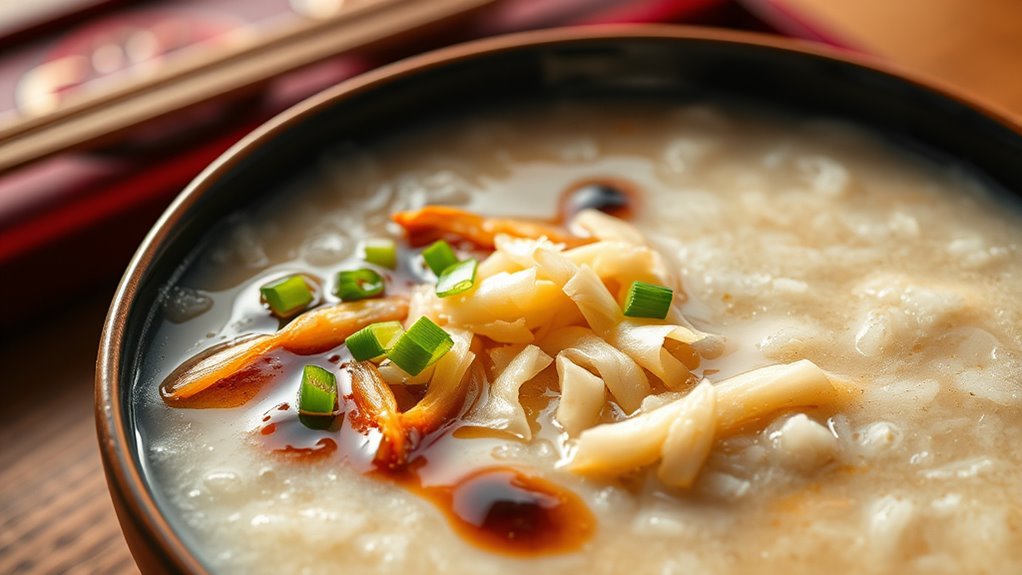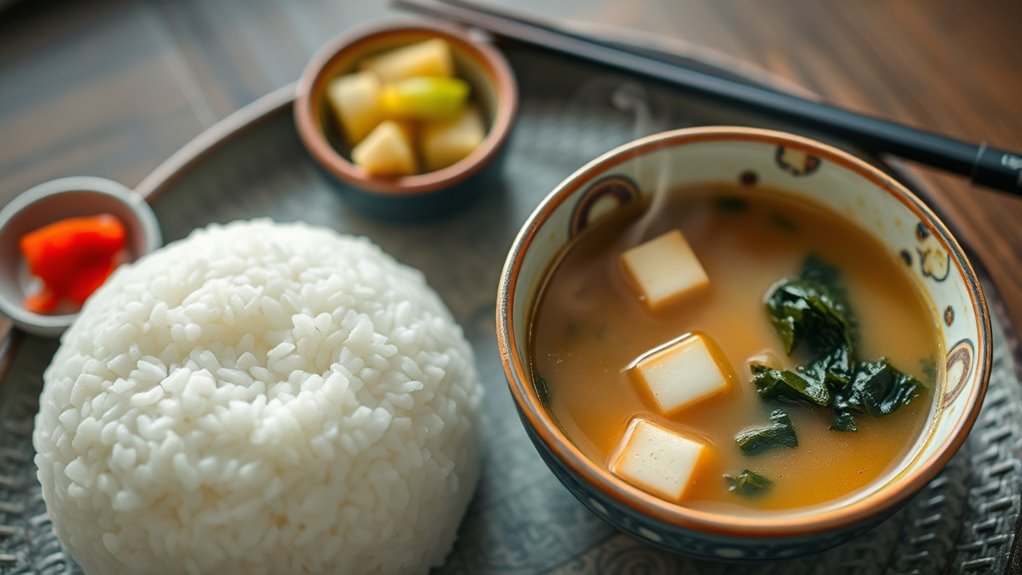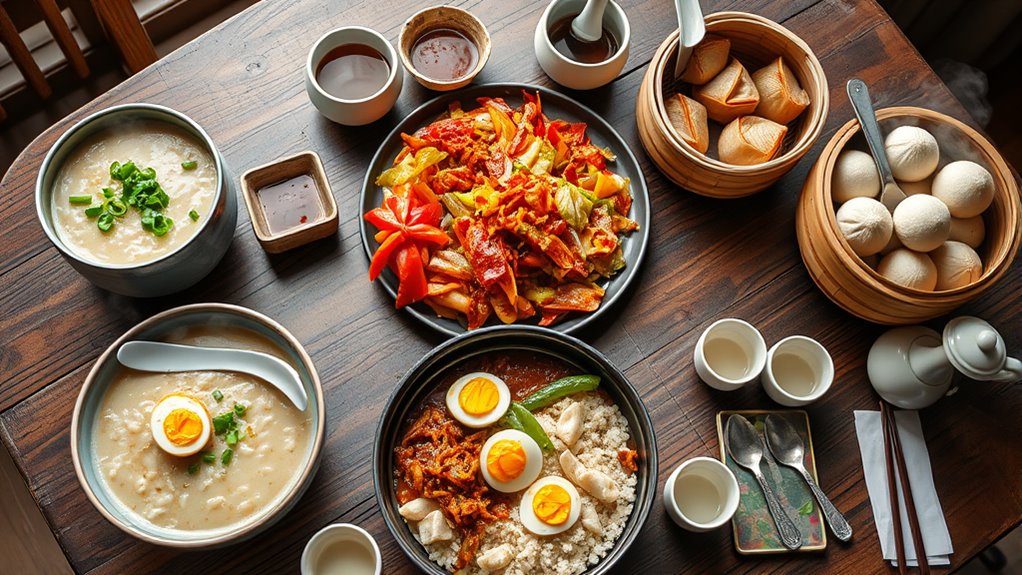In Asia, breakfast varies widely—from warm, comforting congee in China, to hearty rice and miso soup in Japan, and tangy kimchi alongside rice in Korea. Indian mornings feature crispy dosas and fluffy idlis, while Southeast Asian dishes like Nasi Lemak and Pho showcase bold flavors. Traditional customs blend with modern twists, creating exciting fusion ideas. Explore more to discover how these diverse breakfasts reflect rich cultures and evolving culinary trends across the continent.
Key Takeaways
- Asian breakfasts are deeply rooted in cultural traditions, with staples like congee in China and rice-based dishes in Japan and Korea.
- Congee symbolizes comfort and family bonding, often sharing toppings like preserved eggs, pickled vegetables, and pork floss.
- Kimchi, a fermented vegetable dish, is central to Korean breakfast, offering probiotic benefits and complex flavors.
- Breakfast customs vary across Asia, including Japanese miso soup, Indian dosas, and Southeast Asian street foods like Pho and Nasi Lemak.
- Modern fusion trends blend traditional ingredients like congee and kimchi with global flavors, creating innovative breakfast options.
Chinese Congee: A Comforting Tradition

Chinese congee is a beloved breakfast staple that offers warmth and comfort at the start of the day. When you enjoy congee, you often observe traditional breakfast etiquette, which emphasizes harmony and respect. Congee’s gentle, soothing texture pairs perfectly with tea ceremonies, a cultural ritual that highlights mindfulness and appreciation. During breakfast, it’s common to serve congee with a variety of toppings like preserved eggs, pickled vegetables, or pork floss, enhancing both flavor and experience. The act of sharing congee reflects family bonds and cultural values. As you partake in this meal, you connect with centuries-old customs that emphasize simplicity, balance, and reverence, making your morning not just nourishing but also culturally meaningful. Additionally, the colorful variety of toppings allows for personalized flavor profiles, enriching the dining experience.
Japanese Breakfast Staples: Rice and Miso Soup

In Japan, breakfast often centers around simple yet nutritious staples like steamed rice and miso soup. These dishes form the backbone of a traditional morning meal, providing energy and comfort. You might start with a bowl of warm miso soup, filled with tofu, seaweed, and green onions, which is both soothing and nourishing. Alongside, steamed rice serves as a versatile base, often accompanied by small side dishes like pickles or grilled fish. Breakfast beverages include hot green tea, which is commonly enjoyed during or after a quick tea ceremony, emphasizing mindfulness and tradition. The ritual of tea ceremonies highlights the significance of tea in Japanese culture, making it more than just a beverage but a moment of calm and reflection to begin your day. Incorporating traditional dining customs can enhance the authenticity and mindfulness of your morning routine.
Korean Morning Delights: Kimchi and More

Building on Japan’s focus on wholesome flavors, Korean breakfasts showcase bold, fermented tastes that invigorate your morning. Central to this is kimchi, a staple of fermented vegetables with a tangy, spicy kick. It’s often served alongside rice, soups, and other dishes, adding complex flavor and beneficial probiotics. Alongside kimchi, you’ll find an array of spicy condiments that elevate simple ingredients into flavorful delights. These spicy sauces and pastes, like gochujang, serve as essential flavor boosters, giving your breakfast a fiery depth. The emphasis on fermentation not only enhances taste but also supports digestion, making your morning both delicious and nourishing. Additionally, understanding fermentation techniques can help you make more authentic and flavorful dishes at home. Korean breakfast spreads embrace bold, spicy, and tangy flavors that awaken your senses and set a lively tone for the day.
Indian Breakfast Variations: Dosas, Idlis, and Parathas

Indian breakfasts feature a variety of delicious options like crispy dosas, soft steamed idlis, and flaky parathas. Each dish offers unique textures and flavors that reflect regional traditions. You’ll find these staples served with flavorful chutneys and spicy accompaniments. For those seeking convenience, vetted appliances for easy preparation can make these dishes more accessible at home.
Dosas: Crispy Crepes
Dosas are a beloved street food and breakfast staple, celebrated for their crisp texture and versatility. Achieving perfect dosa batter techniques is key to getting that ideal crunch and flavor. You start by soaking rice and urad dal, then grinding them into a smooth, fermenting batter. The batter’s consistency influences the crispness of your crispy crepe variations. When cooking, spread the batter thin on a hot griddle, ensuring even thickness for maximum crunch. As they cook, dosas develop a golden-brown, crispy exterior while remaining tender inside. You can fill or serve them with a variety of ingredients, from spiced potatoes to chutneys. Mastering the batter and cooking technique allows you to create dosas that are both crispy and flavorful, perfect for a satisfying Indian breakfast.
Idlis: Steamed Rice Cakes
Idlis are soft, fluffy steamed rice cakes that are a popular breakfast choice across India. You’ll often find them served with sambar and coconut chutney, making for a hearty start to the day. These rice cakes are also common street food, enjoyed as quick bites on busy mornings. During festivals, idlis transform into festive dishes, carved into intricate shapes or served with special accompaniments. When you bite into an idli, you experience a light, airy texture that’s perfect for dipping or scooping. They’re often part of a traditional Indian breakfast spread, offering a wholesome, nourishing meal. From bustling street stalls to family celebrations, idlis hold a special place in Indian culinary culture. Their versatility makes them beloved across many regions.
Parathas: Flaky Flatbreads
Have you ever enjoyed the crispy, flaky layers of a freshly made paratha? These delicious flatbreads showcase expert cooking techniques that create their signature texture. To make a perfect paratha, you roll out dough made from wheat flour, water, and a pinch of salt, then layer it with ghee or oil before folding and rolling it again. Ingredient variations abound, with options like adding chopped greens, spices, or even stuffed fillings such as potatoes or paneer. As you cook each paratha on a hot griddle, it develops a golden crust while remaining tender inside. The key is controlling heat and applying the right amount of fat to achieve that flaky, layered structure. Parathas are versatile, satisfying, and a beloved Indian breakfast staple. Incorporating music therapy principles such as mindfulness and focused attention during preparation can enhance the cooking experience and promote relaxation.
Southeast Asian Flavors: Nasi Lemak and Pho

What makes Nasi Lemak and Pho standout breakfast dishes across Southeast Asia? It’s their deep roots in street food culture and vibrant street markets. These dishes are more than meals; they’re cultural icons enjoyed daily. When you visit a street market, you’ll see steaming bowls of Pho bubbling away, inviting you to slurp with fresh herbs and spices. Nasi Lemak, wrapped in banana leaves, offers fragrant rice paired with crispy anchovies, boiled eggs, and spicy sambal. Both dishes highlight local flavors and the lively energy of street vendors. Their popularity comes from being hearty, flavorful, and accessible, making them breakfast staples across Southeast Asia’s bustling streets. Street food culture plays a vital role in preserving traditional culinary techniques and fostering community connections.
Modern Twists and Global Influences on Asian Breakfasts

Modern twists and global influences are transforming traditional Asian breakfasts in exciting ways. You’ll see fusion dishes that combine familiar flavors with international ingredients, creating new breakfast experiences. Regional flavor integrations also highlight how local tastes adapt and evolve in today’s interconnected world. Incorporating practical tips can help home cooks experiment with these innovative recipes while maintaining a sense of authenticity.
Fusion Breakfast Innovations
Across Asia, traditional breakfast dishes are increasingly being reimagined through fusion innovations that blend local flavors with global culinary trends. You’ll find inventive options like fusion brunch plates that combine familiar ingredients with international twists, creating exciting new flavors. Breakfast innovation is happening everywhere, from Tokyo to Bangkok, transforming classic dishes into contemporary delights. For example, you might enjoy a kimchi quesadilla or a congee bowl topped with avocado and salsa. These creative takes appeal to diverse tastes and reflect a globalized palate. Fusion breakfast innovations not only preserve cultural roots but also invite experimentation, making breakfast more dynamic. Incorporating diverse culinary influences is also key to this movement, allowing traditional Asian breakfasts to evolve while respecting their origins. This culinary blending sparks curiosity and broadens your breakfast choices, turning morning meals into exciting culinary adventures.
Regional Flavor Integrations
Regional flavors are being reimagined through modern twists and global influences that transform traditional Asian breakfasts. You might find a bowl of congee infused with Western herbs or topped with international condiments like avocado or sriracha. Breakfast beverages now blend local ingredients with global trends, such as matcha lattes or coconut smoothies, offering new ways to enjoy familiar tastes. Regional condiments like soy sauce, gochujang, or fish sauce are adapted into contemporary dishes, adding depth and complexity. These integrations allow you to experience familiar flavors in innovative formats, bridging tradition and modernity. Additionally, understanding cultural influences helps explain how global trends shape regional cuisines today. As you explore Asian breakfasts today, you’ll notice how traditional recipes are evolving, embracing global ingredients and techniques while honoring regional culinary roots.
Frequently Asked Questions
What Are Some Common Beverages Served With Asian Breakfasts?
When you’re having breakfast in Asia, you’ll often find tea varieties like green, jasmine, or oolong served alongside. These beverages complement the flavors of dishes like congee or kimchi. Sometimes, you might also enjoy fruit accompaniments such as fresh slices or pickled fruits, which add a revitalizing touch. These drinks help start your day with warmth and balance, enhancing your overall breakfast experience across the diverse Asian cuisines.
How Do Regional Climates Influence Breakfast Ingredient Choices?
You notice that regional climates greatly influence breakfast ingredient choices through climate-based ingredient variations and regional flavor adaptations. In cooler areas, you find heartier, warming foods like congee or noodle soups, while hotter regions favor lighter, invigorating dishes like rice porridge or pickled vegetables. These adaptations help you enjoy breakfast that suits the climate, ensuring comfort and vitality, and reflect local ingredients and culinary traditions tailored to the environment.
Are There Vegetarian or Vegan Options Prevalent in Asian Morning Meals?
Think of Asian mornings as a garden bursting with plant-based dishes. You’ll find many vegan-friendly options like tofu stir-fries, vegetable congee, and fresh fruit. Vegetarian and vegan dishes are common, offering delicious, healthy starts to the day. These options suit diverse dietary needs and reflect cultural traditions. So, yes, you’ll discover plenty of plant-based dishes, making Asian breakfasts both flavorful and inclusive for everyone seeking vegan-friendly options.
How Have Traditional Asian Breakfasts Adapted to Modern Lifestyles?
You see, traditional Asian breakfasts have adapted to modern lifestyles by embracing fusion cuisines and quick, portable options. You might find contemporary takes on breakfast rituals, like rice bowls with Western toppings or grab-and-go bao buns. These innovations blend cultural flavors, making breakfast more convenient yet rooted in tradition. This evolution helps you enjoy a nutritious start to your day while respecting age-old customs and keeping up with busy schedules.
What Are the Health Benefits of Typical Asian Breakfast Ingredients?
You might notice that Asian breakfast ingredients often offer surprising health benefits. Their nutritional value boosts your energy and supports digestion naturally, while traditional remedies embedded in dishes like kimchi and congee promote gut health and immunity. These ingredients are more than just delicious—they serve as everyday medicine, helping you stay balanced and strong. Embracing these foods connects you to centuries of wisdom, turning breakfast into a nourishing ritual.
Conclusion
As you explore Asia’s breakfast traditions, you realize they’re more than just meals—they’re stories waiting to be uncovered. Each dish hints at history, culture, and evolving tastes, leaving you curious about what’s next. Will new flavors emerge or ancient recipes find new life? The journey through Asian breakfasts is far from over, and the delicious mystery of what’s to come keeps you enthusiastic to taste, learn, and discover more.










